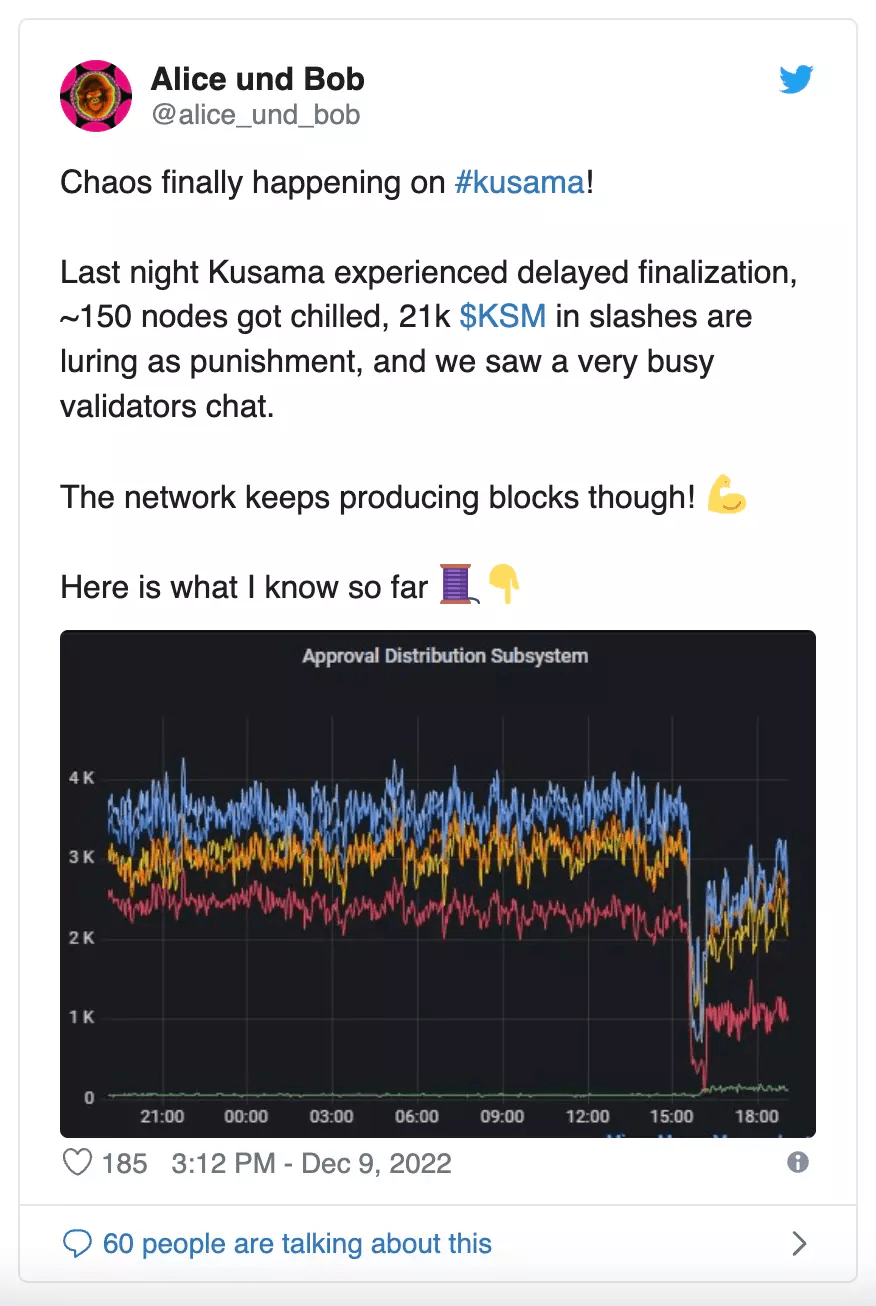
On December 9, 2022, at the block height of #4543 on the Kusama network, a Slash manslaughter incident occurred. A validator broadcasted a large amount of controversial information, which blocked the network, causing numerous validators to go down.
Kusama recently experienced a unique situation with its validators, deeming 155 validators maliciously offline and slashing 21,000 KSM in the aftermath. Researchers are currently exploring the underlying motivations for this incident to ensure adequate solutions in the future.

Dec 9th, only nine Bifrost SLP validators faced the consequences of the Slash incident, having 711 KSM tokens from a total stake of 237,000 slashed. Details are as follows:

The SLP protocol has automatically canceled the delegation of these validators for the first time and removed them from the VWL (Validator White List).
On December 11, the Kusama community passed a governance referendum 16, revoked these Slashes, lifted the freezing of these validators, restarted the validator election, and restored the normal state of the network. The Slash related to the SLP validators has also been revoked, and the vToken income held by users and the vToken exchange rate will not be affected.
Slash is a tool used by the PoS protocol to punish negative behavior by validators. However, the network will experience a Slash when the validator exhibits production or signature conflicting blocks, malicious disconnection, manipulation with the client application, and other behaviors that jeopardize the security of the PoS network. The Slash extent depends on the network violation. Slash is an essential tool for preserving the PoS network’s security.
However, Slash is more of a deterrent to encourage validators to perform their duties faithfully. In the network operation, Slash rarely occurs, such as the large-scale Slash of the Kusama manslaughter incident, which is even rarer. Less, it is a black swan event.
With the possibility of loss through Slash unbearable, the Bifrost SLP protocol presents a solution for Stakers seeking risk control in their PoS staking ventures. This pool-based model offers an attractive alternative that grants greater security and peace of mind. This is because:
The SLP protocol as a whole bears the Slash risk, and for each vToken holder, the risk is diluted.
Compared with individual Stakers, the SLP protocol is a smarter Staker, and it will adopt better strategies than individual Stakers to balance the rate of return and Slash risk. The SLP protocol will make a detailed score based on the historical stability, security credit, leverage ratio, yield rate, and other indicators of the validator and select and adjust the entrusted validator set based on this score. Compared with individual Stakers, SLP will have a more comprehensive inspection of validators and the number of validators entrusted and their degree of dispersion will be higher, which can minimize and mitigate the risk of Slash.
SLP can swiftly modify the set of validators they entrust, enabling rapid response in the event of a slash. The Kusama incident offers an exemplary case study; the network identified nine slashed validators, and initiated their removal from the whitelist almost immediately. The reaction was faster than any individual Staker could react and make adjustments even if they noticed first-hand.
The SLP protocol sets up an insurance mechanism that provides users with a buffer compensation when a Slash occurs. See below for details.
If a slash occurs, depending on the severity, the SLP will enable different compensation mechanisms.
1/ Each Era of a validator gives SLP settlement income (one Era in Kusama is 6 hours). If the current Era settlement income is greater than the Slash amount, the current Era’s rate of return is still positive, and the situation will not trigger compensation.
2/ If the current Era’s Slash amount exceeding the income and the current Era’s yield is negative, the scenario will trigger compensation. The SLP protocol will destroy part of the vToken in the vToken Vault to offset the impact of Slash, making the current Era rate of return 0.
3/ If the number of vTokens in the vToken Vault is not enough to completely offset the Slash impact, all the vTokens in the vToken Vault will be destroyed to reduce the Slash loss. But at this time, the current Era yield rate will still be negative, meaning the vToken redemption rate will decrease (a lower current Era, vToken/Token exchange rate).
Users have access to a dependable insurance pool by utilizing the vToken Vault. During the minting and redeeming of vTokens, the Vault receives 5% of the commission fee, meaning that over time its amount increases — which in turn leads to better security assurance for SLP protocol operations down the line.
Each vToken Vault is independent, and the vDOT Vault will not be used to compensate for the losses that should be paid by the vKSM Vault.
The recent Slash turmoil on the Kusama network caused some alarmingly late-night wake-ups for validator operators and users, primarily in Europe. But with a swift Proposal cancellation implementation by leadership, there were no long-term effects to follow up from this incident — a true testament of why “No promises, Expect Chaos” is embedded into their community values! The efficient Slash situation handling granted satisfaction across the board, which numbed any possible criticism.
Bifrost’s partners noted the Slash incident and inquired about countermeasures. To engage in responsible governance, nine validators affected by this withdrawal duly pushed for re-election. These individuals had a strong chance of being chosen again due to an absence of loss from slash removal.
As a liquidity staking protocol, Bifrost SLP not only releases the liquidity of Staking assets for users, but also provides users with a complete set of solutions to avoid and share Slash risks, reduce and compensate Slash losses. It is a better strategy for users to participate in the pledge of the PoS network through SLP than to directly participate in the staking as an individual.